TORONTO - There is more variation in breast cancer than current treatment approaches acknowledge, according to the largest effort to date to distinguish between and find out what's driving breast cancer tumours.
The work, by a consortium of Canadian, British and other researchers, suggests there are at least 10 subtypes of breast cancer, an increase from the current belief that these tumours can be classified into four or five types.
The findings, published Wednesday in the journal Nature, are based on the detailed study of more than 2,000 breast cancer tumours and should have major implications for treatment of the disease.
"If you believe one breast cancer to be the same as any other breast cancer — but it really isn't — then you're really applying therapies that either may be ineffective or worse, actually quite toxic, and not produce benefit," senior author Dr. Samuel Aparicio of the B.C. Cancer Agency explained in an interview.
The findings point to a time when medicine will be able to more accurately target breast cancer therapy, knowing which tumours require aggressive treatment and, conceivably, which might be safely treated with a minimalistic approach because they are unlikely to be dangerous.
"What we anticipate is that in the future, the knowledge of the genes that are mutated in these specific subtypes will lead us to two things," Aparicio said.
"One is a better way of predicting whether existing therapies are going to be useful or not in a particular subtype. And the other is that it's taking us into the domain of having to develop new drugs. We see from the variation that we just don't have enough drugs being developed yet to combat each of these different subtypes."
The work was done by scientists from the B.C. Cancer Agency, the University of British Columbia, Cambridge University in Britain and the University of Manitoba's Institute of Cell Biology, among other institutions in Britain, the United States and Norway.
They studied both the DNA and RNA of this large group of tumours, looking for genetic faults — mutations — that spur development of cancer. In the process, they discovered several genes that had not previously been linked to breast cancer development.
They were looking in particular for "driver mutations" — changes that seem to trigger cancer development and growth. These mutated cells are potentially useful both for predicting the course a cancer will take and as a target for a drug therapy.
"If we want more success against the harder-to-treat cancers, we're going to have to develop more drugs and learn how to combine them. And this gives us a road map for that," Aparicio said.
Being able to distinguish one type of breast cancer from another is important in figuring out how aggressively to treat the tumour.
In one type of estrogen-receptor or ER positive breast cancer, about 70 per cent of women are still alive 15 years after their diagnosis. But another type of ER positive breast cancer has a much poorer prognosis; at 15 years, only 30 per cent of women with this type of tumour are still alive.
The implication: In the quest to successfully treat the women with the more aggressive cancer, doctors are likely subjecting some women to treatments they don't actually need.
"It's very hard to distinguish those patients at the moment," Aparicio said.
"It's not desirable to over-treat patients, of course. But the current situation is really dictated by a lack of knowledge as to who will respond and who won't."
Aparicio and his co-authors liken their findings to an encyclopedia of breast cancer, though they admit more chapters will be written as future work reveals finer distinctions between the various groupings. As it is, although most of the subtypes seem to fall into distinct groups, in a couple of cases the divisions are more hazy.
Now work needs to be done to test treatment regimes within the groups to see whether enough has been learned to be able to determine the best treatment approaches for each of the subtypes.
"So we're definitely seeing those sub-groups," said Aparicio. "And we now need to go out and test, formally in a clinical trial setting, whether stratifying treatment on that basis will reduce morbidity."
 By: The Kit
By: The Kit











